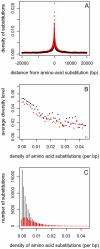Pervasive adaptive protein evolution apparent in diversity patterns around amino acid substitutions in Drosophila simulans
- PMID: 21347283
- PMCID: PMC3037414
- DOI: 10.1371/journal.pgen.1001302
Pervasive adaptive protein evolution apparent in diversity patterns around amino acid substitutions in Drosophila simulans
Abstract
In Drosophila, multiple lines of evidence converge in suggesting that beneficial substitutions to the genome may be common. All suffer from confounding factors, however, such that the interpretation of the evidence-in particular, conclusions about the rate and strength of beneficial substitutions-remains tentative. Here, we use genome-wide polymorphism data in D. simulans and sequenced genomes of its close relatives to construct a readily interpretable characterization of the effects of positive selection: the shape of average neutral diversity around amino acid substitutions. As expected under recurrent selective sweeps, we find a trough in diversity levels around amino acid but not around synonymous substitutions, a distinctive pattern that is not expected under alternative models. This characterization is richer than previous approaches, which relied on limited summaries of the data (e.g., the slope of a scatter plot), and relates to underlying selection parameters in a straightforward way, allowing us to make more reliable inferences about the prevalence and strength of adaptation. Specifically, we develop a coalescent-based model for the shape of the entire curve and use it to infer adaptive parameters by maximum likelihood. Our inference suggests that ∼13% of amino acid substitutions cause selective sweeps. Interestingly, it reveals two classes of beneficial fixations: a minority (approximately 3%) that appears to have had large selective effects and accounts for most of the reduction in diversity, and the remaining 10%, which seem to have had very weak selective effects. These estimates therefore help to reconcile the apparent conflict among previously published estimates of the strength of selection. More generally, our findings provide unequivocal evidence for strongly beneficial substitutions in Drosophila and illustrate how the rapidly accumulating genome-wide data can be leveraged to address enduring questions about the genetic basis of adaptation.
Conflict of interest statement
The authors have declared that no competing interests exist.
Figures



References
-
- Li H, Stephan W. Inferring the demographic history and rate of adaptive substitution in Drosophila. PLoS Genet. 2006;2:e166. doi: 10.1371/journal.pgen.0020166. - DOI - PMC - PubMed
-
- Jensen JD, Thornton KR, Andolfatto P. An approximate bayesian estimator suggests strong, recurrent selective sweeps in Drosophila. PLoS Genet. 2008;4:e1000198. doi: 10.1371/journal.pgen.1000198. - DOI - PMC - PubMed
-
- Begun DJ, Holloway AK, Stevens K, Hillier LW, Poh YP, et al. Population genomics: whole-genome analysis of polymorphism and divergence in Drosophila simulans. PLoS Biol. 2007;5:e310. doi: 10.1371/journal.pbio.0050310. - DOI - PMC - PubMed
Publication types
MeSH terms
Grants and funding
LinkOut - more resources
Full Text Sources
Molecular Biology Databases
Research Materials

